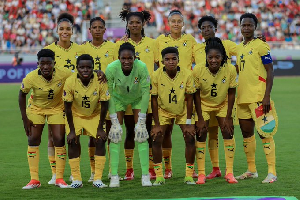Business News of Tuesday, 11 October 2016
Source: B&FT
Local investors lap up first USD bond
The subscription period ends Thursday, October 13, 2016, but the first ever USD-denominated domestic bond issued by government and targeted at investors resident in Ghana and Ghanaians abroad, has been well received, with bids rushing in, bookrunners have told the B&FT.
“We have people calling everyday about how to get their bids in; it has been a good book building process,” a representative of one of the lead arrangers – Barclays Bank, Stanbic Bank and Strategic African Securities – told the B&FT.
The bond has a two-year, short-term tenor, which an analyst who pleaded anonymity said is so because government wants to test the domestic market’s appetite for USD-denominated treasury bonds.
The Finance Ministry suggests around US$50million will be raised through the debut USD-denominated bond, which a notice from the central bank said is aimed at exploring alternatives to meeting government’s financing needs, and to deepen the capital market.
“The short tenor is consistent with the fact that this is a debut issuance aimed to test appetite since a longer tenor would have been over-ambitious and ill-advised,” the analyst said.
The BoG notice said the subscription lasts from October 3 to October 13, 2016, and that the minimum subscription for investment is US$10,000, “and integral multiples of US$1,000 above the minimum size.”
“The bond is open to investors resident in Ghana and non-resident Ghanaian investors, who have USD balances in their Foreign Exchange Accounts (FEA) and Foreign Currency Accounts (FCA),” the notice, posted on the central bank’s website, said.
Set to be traded on the Ghana Fixed Income Market (GFIM) platform, the bond has an indicative pricing of between 5.5 to 6.5percent, the bookrunners’ representative said.
Armah Akotey, Head of Brokerage at Databank, told the B&FT that the USD bond should come as welcome news to investors, saying: “dollar deposits with banks might not earn you much, so if government offers you 4 or 5percent risk free, it is better you place your dollars with this bond.”
The dollar option, he said, is cheaper for the government too which has had to pay on average 24percent on its cedi denominated bonds.
Ghana’s foreign debts, which include the Eurobonds, have come at far cheaper rates as compared to local short term debts.
With high interest rates on short term local-currency denominated debt, the government, since a year ago, has been exploring other options, mainly long term and outside the country, to raise debt to retire maturing debt, pay interest on debt and fund infrastructure projects.
The local currency, despite coming under a bit of pressure to sell at GH¢3.95 to the USD in September, has shown signs of stability for the first nine months of the year, losing ground by just about 3percent, compared to 15percent in 2015.
RMB Global Markets Research, the South African research based institution, noted in its weekly currency update that though the local unit weakened in September due to robust corporate demand, “on the bright side, US$800million of COCOBOD syndicated loan flows are expected to be directly injected into the FX market, with the rest bring used to shore up reserves.”
Analysts note that a little instability in the currency market could result in an increase in the interest paid on this two-year dollar denominated domestic bond.
Should it be successful, however, it will serve as another avenue for the cedi to be further strengthened since the funds raised will be in dollars and will be used to repay interest on foreign currency denominated debt, thereby reducing pressures on the cedi denominated revenue relied on by the government to repay these loans.
“Part of the government’s expenditure is incurred in dollars, like servicing foreign debt and purchasing imports. Meanwhile revenues are generated in cedis. So in trying to borrow dollars at home, they are supporting the cedi because the government’s FX demand to import puts pressure on the cedi. Indirectly it is something to support exchange rates,” the analyst said.
Ghana’s total public debt now stands at GH¢109 billion as at July 2016, which translates into about 65.9 percent of GDP, according to data released by the central bank.
The debt stock, according to the Central Bank, grew from GH¢101.1billion in January to about GH¢108.9 billion as at the end of July this year.
In terms of the composition of the debt, there was virtually no increase in the external debt component, which only rose to GH¢60.7billion from GH¢60.6billion, and remained at 36.4 as a percentage of GDP. But then the government picked up US$750million Eurobond in September.
Total interest payment is estimated at GH¢10.5billion, equivalent to 6.6percent of GDP and 24.1 percent of total expenditure. Of this amount, GH¢2.2billion will be expended on external interest, while GH¢8.2 billion will be for domestic interest payments.
Also the amount to be spent on interest payments this year dwarfs the GH¢6.7 billion planned for capital expenditure. As a percentage of total expenditure, interest payments will account for about a quarter while capital expenditure makes up 12.7 percent.
High demand to set precedent
A high demand for this bond will set the precedent for the government to venture into dollar denominated domestic bonds which will further reduce the government’s foray into the domestic local currency market, thereby freeing up capital for the private sector.
Already, government has said it intends to raise a five-year bond of GH¢1billion, part of which may be issued in USD.
Also, analysts believe it will also deepen the financial market since a new innovative market gives more options for investors to trade and increase liquidity on the market.
“If this is successful, it lays the foundation for similar such issuances in the future by the government and then the private sector can also issue dollar bonds at home in the local market. The depth of the financial market is measured by the variety of products on the market,” the analyst said.












